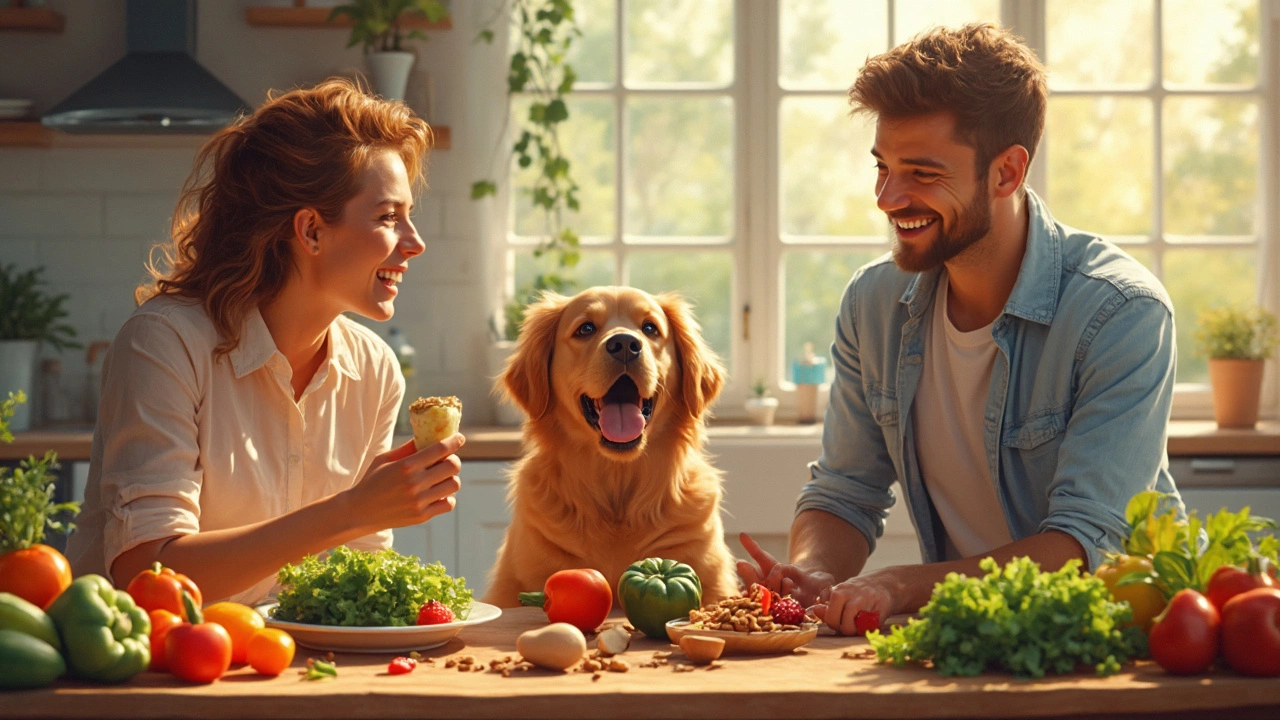So you're standing in the pet food aisle, staring at rows of bags and cans, feeling a bit overwhelmed about which is the healthiest food for your furry buddy. It's not as simple as it seems, right? Dogs have different nutritional needs from humans, so what works for us might not be great for them. Let's unpack this a bit and make sense of what your pup really needs to thrive.
First off, dogs require a balance of proteins, fats, and carbohydrates. Protein is the big player here—it builds muscle and keeps their energy levels up. Fats are crucial too, ever noticed your dog’s shiny coat? Thank fats for that! But carbs, while not essential, can be a good energy source. Oh, and let's not forget about vitamins and minerals, the unsung heroes keeping your pet's body functioning smoothly.
When it comes to picking ingredients, look for high-quality sources like chicken, lamb, or beef as the primary protein. Grain-free isn’t always the healthiest option, despite the hype. Whole grains can actually be good for some dogs unless they have specific allergies. Speaking of which, be aware of any allergies your dog might have and adjust the diet accordingly.
- Understanding Canine Nutritional Needs
- Best Ingredients for a Healthy Dog Diet
- Commercial vs. Homemade Dog Food
- Tips for Choosing the Right Dog Food
Understanding Canine Nutritional Needs
Ever wonder what makes your dog tick food-wise? Unlike humans, dogs thrive on a diet that's a bit different but just as particular. The cornerstone of a dog's nutrition is protein, which isn't just for bodybuilders. For dogs, protein builds muscle, repairs tissues, and provides energy. It's like their body's multi-tool.
Next up is fat. While "fat" might sound like a no-no, it's crucial for your canine. Fats provide a dense energy source. They've got twice the energy punch per gram as carbs and proteins. Plus, they keep that fur coat glossy and healthy. Fatty acids from fish oils or flaxseed also play a big role in boosting their immune system.
While proteins and fats are the MVPs, carbohydrates aren't completely out of the game. They're not technically necessary, but they offer an extra energy source. Think of oatmeal and potatoes – they provide fiber, which helps with digestion. So, ignoring grains isn't always best unless your dog has specific allergies.
Don’t skip out on the vitamins and minerals, either. Vitamin D helps with bone growth, calcium matters for their teeth, and zinc shores up the immune system. All these ensure overall health, from a healthy brain to a wagging tail.
Sometimes, it’s all about the details. Did you know that the size and breed of your dog can affect what nutrients they need? A working dog like a Border Collie might need more calories than a Chihuahua lounging at home all day.
| Nutrient | Function |
|---|---|
| Protein | Muscle growth and energy |
| Fat | Energy and healthy coat |
| Carbohydrates | Additional energy source |
| Vitamins & Minerals | Overall health and immune support |
So, next time you're weighing options for your dog food, remember it's not just about fancy packaging. Think about what goes inside and how it fuels your furry friend's escapades.
Best Ingredients for a Healthy Dog Diet
Picky about what’s on your plate? Well, your dog deserves high standards too when it comes to their food. Not all dog foods are created equal, so let’s dive into some ingredients that work wonders for your pup’s health.
First, check the protein source. You want to see meat like chicken, beef, or lamb as the first ingredient. These proteins help build and maintain your dog’s muscles. Avoid ambiguous terms like 'meat meal' and go for something clearly stated.
Fats are equally crucial, coming from sources like fish oil or chicken fat. They’re not just about giving dogs shiny coats but also supporting brain function and energy levels. Omega-3 and Omega-6 are your heroes here.
Then we have carbohydrates. Despite what you've heard, grains aren't always bad for dogs. Look for whole grains like brown rice or oats, which provide energy and fiber. If your dog’s sensitive to grains, sweet potatoes can be a fantastic alternative.
- Fruits and veggies aren't just human food. They bring fibers, vitamins, and antioxidants. Think carrots or blueberries, sparking up both flavor and nutrition.
- Ever heard of glucosamine and chondroitin? These supplements are great for joint health, especially in older dogs.
- Probiotics and prebiotics support a happy gut. A healthy digestive system means a happy dog!
While choosing the right dog food, always check the back of the pack for these ingredients. But remember, every dog’s different, so what works wonders for one might not suit another.

Commercial vs. Homemade Dog Food
Deciding between commercial dog food and whipping up meals at home? It's a topic that stirs quite the debate among pet owners. Let’s break this down so you can make the best choice for your pup.
Commercial dog food offers convenience and balanced nutrition that's usually backed by research. These foods are formulated to meet the dietary needs of dogs at various life stages. They're regulated by bodies like the Association of American Feed Control Officials (AAFCO), which means you get a product that should meet certain nutritional standards. Plus, if you're not a wizard in the kitchen or short on time, grabbing a bag off the shelf is way easier.
On the flip side, making homemade dog food gives you full control over what your pooch eats. You can handpick ingredients, ensuring they're fresh and, in your view, the healthiest option. It’s particularly handy for dogs with specific allergies or sensitivities. However, it can be tricky to get all the nutrients your dog needs without some guidance. Consulting with a vet or pet nutritionist is a good step to ensure your homemade diet is balanced right.
When considering commercial dog food, look out for brands that list a specific meat as the first ingredient and avoid unclear labelling like ‘meat by-products.’ If you opt for homemade, remember it's not just about mixing chicken and rice. Dogs need a balance of protein, carbohydrates, fats, vitamins, and minerals. Think about adding a variety of vegetables and a source of omega fatty acids to their bowls.
There's also an emerging trend of fresh dog food delivery services that aim to blend the best of both worlds: convenience and tailored nutrition. These meals are often cooked then frozen and delivered straight to your door, so everything's ready to go.
Still unsure? Here's a quick comparison:
| Aspect | Commercial Food | Homemade Food |
|---|---|---|
| Convenience | High | Low to Medium |
| Nutritional Balance | Usually balanced | Requires planning |
| Customization | Limited | High |
| Cost | Varies | Varies, often higher |
Ultimately, whether you go commercial or homemade, the healthiest food is the one that meets your furry friend's unique needs. Watch their energy levels, coat condition, and digestion to see if the food's a good fit. After all, a happy dog is a healthy dog!
Tips for Choosing the Right Dog Food
Picking the right food for your furry friend isn’t just about grabbing whatever bag looks good on the shelf. It's more like detective work, and you need to pay attention to a few important details. The journey to finding the healthiest food for your dog involves understanding their unique needs and digging into the nitty-gritty of nutrition labels.
First things first—know your dog. Consider their age, size, activity level, and health status. Puppies need different nutrients than older dogs, just like super active pups will have different energy requirements than couch potatoes.
Next, let's talk labels. Not every ingredient list is straightforward. Look for real meat like chicken or beef as a top ingredient, and steer clear of food with vague terms like 'meat by-products.' A real protein source listed first is usually a good sign. Also, check for artificial preservatives, which can sometimes lead to allergies or health issues over time.
- Consider dietary needs: If your dog is allergic to grains, pay attention to grain-free options, though they're not a must-have for all dogs.
- Check for available certifications: Products approved by the Association of American Feed Control Officials (AAFCO) often meet the standards dogs need for a balanced diet.
- Evaluate the food type: Whether it’s dry, wet, or a combination, each has its pros and cons. Dry food typically helps with dental health, while wet food can be great for hydration.
- Consult the vet: Before making any drastic changes, a quick chat with the vet can ensure you’re on the right path and help customize a plan that suits your pet’s specific requirements.
Another handy tip? Don’t go cheap. While budget matters, feeding your dog is not just an expense—it's an investment in their health. A quality diet often translates to fewer vet bills down the road.
A small side note about trends: while they sound tempting, not every trendy dog food is beneficial. Keep an eye out for scientifically backed options rather than simply popular ones. All this might sound like a lot, but each step brings you closer to keeping your buddy wagging happily and healthily.
